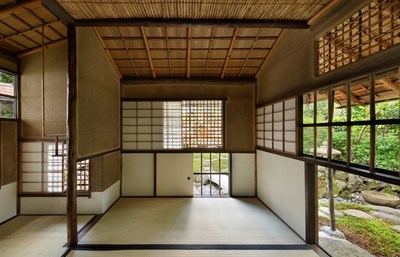Japan House London Presents Windowology: New Architectural Views From Japan

Japan House London Presents Windowology: New Architectural Views From Japan
Windowology: New Architectural Views from Japan shines a spotlight on the humble window, examining the impact they have on us every day.- The exhibition explores the different perspectives on the world that windows offer us, considering the role of windows in disciplines such as architecture, film, craft manufacture, manga and motion.
- Visitors can walk through a full-scale replica of the 17th century architectural plan of Y?suitei teahouse in Kyoto – also known as the J?sans?noseki (13-window sitting room) – renowned for having the most windows among all existing teahouses.
- Artist Tsuda Michiko creates a window-themed installation allowing visitors to Japan House inside, and visitors on Kensington High Street and Derry Street outside, to interact with each other, distorting the boundaries between the streetscape and the interior.
- Produced by the Window Research Institute, the only institution in the world dedicated to the research and development of windows, and leading architectural critic Igarashi Taro.
- Press Preview Monday 29 November; book your place here: jhl@kallaway.com
- Press images available here
LONDON, Sept. 28, 2021 /PRNewswire/ — During the pandemic, for many, windows took on an entirely new meaning. They unlocked our creative and connective potential as hubs for communities to converse, artists to paint and even small businesses to thrive during lockdown.

This new-found appreciation is explored further in this multidisciplinary exhibition from Japan House London. Windowology: New Architectural Views from Japan, running from 1 December 2021 until 10 April 2022, explores the significance of windows beyond what may be considered their primary architectural function – to consider their everyday impact through architecture, photography, manga, craft production, and technology.
Curated by the Tokyo-based Window Research Institute, the only institution in the world focused on the study, design, use and impact of windows, and leading architectural historian and critic Igarashi Taro, this free exhibition looks at the ways in which windows frame our vision to give us unique perspectives on the world.
Core exhibition themes include:
- Windows on teahouses: Enter a full-scale replica of the 17th century okoshi-ezu (three-dimensional architectural plan) of Y?suitei teahouse in Kyoto, constructed from washi (Japanese paper). Famous for its 13 windows despite its small size, each widow is designed to enhance the experience of the tea ceremony via the control of light and breeze.
- Windows on craft: Examine the central role windows play in the creation of Japanese crafts such as ceramics from Mashiko, indigo dyeing and washi from Matsue. Used as ‘working windows’, they bring in wind to dry materials, let out steam, allow items to be smoked or even trap heat – all processes integral to the creation of each craft.
- Windows on manga: Explore one of Japan’s most popular manga series ‘Sazae-san‘. First published in weekly newspapers between 1946 and 1974 and framed within a yonkoma manga (four-cell comic strip), the characters are often depicted sitting in a typical Japanese house, communicating with other characters via neighbourhood windows.
- Windows on how we live now: Discover the works of photographer Jérémie Souteyrat. Interested in the different architectural concepts of windows in Japan, his works highlight how urban windows are carefully positioned in response to sightlines in the surroundings, while rural Japanese homes are often built to capture the natural environment.
- Windows on storytelling: Famous windows in fiction are often used as a place of exchange, a means to indicate separation or even an entrance to another world. The exhibition explores the role of windows in famed Japanese literature throughout the ages, and what this age-old literary device has come to represent.
- Windows on film: Japanese timber-based architecture uses window-like components known as sh?ji (sliding translucent screens) and fusuma (sliding partitions) to create entirely new spaces. A short film on Kikugetsutei – a Japanese teahouse in Kagawa Prefecture – is available to view, revealing, through the rearrangement of ‘window’ spaces, the different ways in which a Japanese building can be completely transformed over a period of 24 hours.
- Windows on the environment: The role of windows in relation to the environment is constantly developing, and Japan is leading the way in creating sustainable architecture. As our interaction with nature becomes increasingly central to building practice, the exhibition explores the way heat, light and wind behave around windows in Japanese houses.
Comments are closed